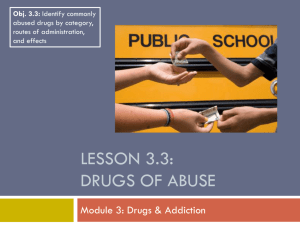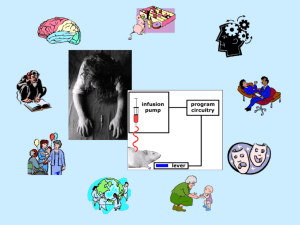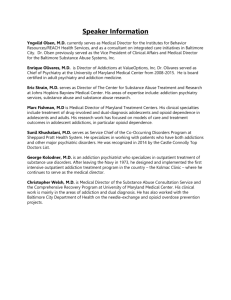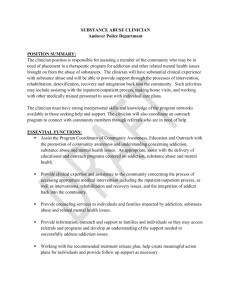NAPPASA Goals and Achievements
advertisement
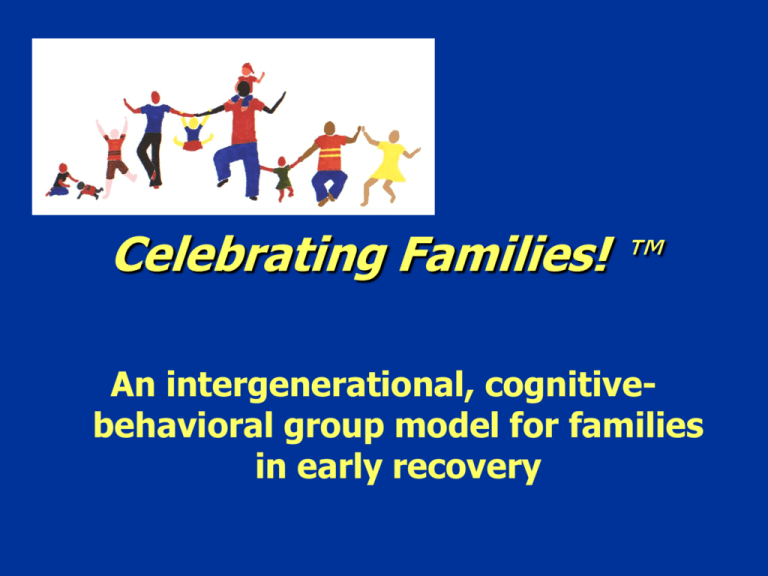
Celebrating Families! ™ An intergenerational, cognitivebehavioral group model for families in early recovery “Celebrating Families! ™ sets the standard with this comprehensive, clear, step-by-step, in-depth guide. This encyclopedic curriculum should be the starting point for anyone who wants to intervene positively with adults and children to build healthy families. Celebrating Families!™ is richly layered on a solid base of research, practical experience and evaluation. This is a curriculum that works!” Stephanie Brown, Ph.D., Director of The Addictions Institute, Menlo Park, Ca. Author of numerous books including Treating the Alcoholic – A Development Model Substance Abuse and Addiction Are primary causes of rise in child abuse, neglect and immeasurable increase in the complexity of cases.* Contribute to 75% of incidents of child abuse and neglect of children in foster care. ** Substance abuse contributes to almost three fourths of incidents of child abuse and neglect of children in foster care. (U.S Department of Health and Human Services, 1999.) *CASA, 1999. **National Center on Addiction and Substance Abuse, 1999 Why A Family Program ? Parents have not received sufficient parenting themselves Court mandated holistic and culturally competent child-centered program can improve parenting capabilities Belief parents love their children Best place for children is with their birth families, when safe Children ultimately at risk to continue cycles Family Interventions WORK! Meta Analytic reviews of randomized clinical trials conclude that treatments that involve family result in Higher levels of abstinence (50 vs. 30%) Fewer drug related arrests (8 vs. 28 %) Fewer inpatient treatment episodes (13 vs. 35%) Science Practice Perspectives. Vol. 2 No 2 August 2004 NIDA. Family Interventions Save Money Estimated cost per participant (40) Year I Year II Estimated cost per child/month in child welfare system (CWS) including indirect Estimated cost including system (medical, law, special education) Cost per month to house youth in county Cost per month to house a youth at CYA * California Child Welfare System – Child and Family Futures ** Edna McConnell Clark Foundation ***Legislative Analyst's Office, 2002-03 George Kita, Former Deputy District Attorney $ $ 990 740 $ 1,945 ** $ 2,123 * $17,584 ** $ 2,600 $ 6,666 *** Why a Specialized Program? All members of a chemically dependent family need to learn: Healthy living skills Communication skills How to sustain recovery How to have positive relationships About the disease Why a Specialized Program? (2) How participants have been affected About recovery Boundaries They are not alone The Truth Statements “Celebrating Families! is a historic groundbreaking program that will serve as a model to help families in other court systems.” Annual Evaluation Report, Center for Local Applied Research, 2004. History 2003: Judge Leonard Edwards requests program SAMHSA grant Children Screened and Assessed Parents Medically Assessed Head Start Family Night (Celebrating Families!) with Transportation and Child Care Team Judge Attorneys: Parent’s, Child’s, District, County Counsel Social Workers and Family Night Coordinator Drug and Alcohol Assessor Public Health Nurse, Mental Health Assessor, Domestic Violence Advocate, Cal-Works, Community Based Agency Representatives (Friends Outside) Family Treatment Drug Court 60 parents and 125 children annually Holistic approach Drugs and Alcohol - Primary drug of choice - meth Domestic Violence Mental Health Diverse Population Serves A Diverse Population Study shows CF! most effective with Hispanic Families 2006 Study shows CF! most effective with Hispanic Families SCC Department of Social Services General Funds provide two nights of Celebrating Families! for ALL Dependency Courts ALL courts in SCC referring ALL families with substance abuse issues to community based sites, using First Five support Breaks the cycle of addiction and abuse in families Impacts the family system Increases successful family reunification Is Unique! Uses teaching strategies effective with individuals with learning differences Integrates teaching of parenting skills with strategies to break the cycle of addiction in families Is Unique! (2) Reinforces and explains what clients learn in treatment and recovery programs Is fully scripted, including role-plays, handouts, children’s stories and activity sheets Teaches Facts about ATOD & Chemical Dependency Recognition of Influence of Media & Advertising Facts about Domestic Violence Teaches (2) Caring & Empathy: Acts of Kindness We are part of something larger than ourselves (WOW Moments) Centering & Reflection Teaches (3) About the disease Facts about ATOD It’s a brain disease That impacts families Self Worth & Self Efficiency: recognizing and celebrating each person’s uniqueness Helps All family members learn and incorporate the Truth Statements into their lives I did not CAUSE the disease. I can not CURE the disease. I cannot CONTROL the disease. I can take CARE of myself – One day at a time Intergenerational, Strength Based, Building Family Skills In Early Recovery Typical Session FAMILY STYLE MEAL CHILDREN’S GROUPS Childcare 90 Minutes Simultaneously + 30 Minutes FAMILY ACTIVITY Transportation PARENT GROUP Typical Session Family Dinner Age-Appropriate Groups Opening Centering Group Agreements & Opening Activity Review (Acts of Kindness) Insights for Living Closing Reflection WOW Moments Connecting With My Family Family Story Children’s Sharing Closing Group Agreements Activity Why Dinner? Kids who eat dinner with their families are less likely to use ATOD Those who did not were 3x more likely to try marijuana, more than 2x as likely to smoke, and 1.5x more apt to drink alcohol "One factor that does more to reduce teens' substance-abuse risk than almost any other is by having frequent family dinners“ The National Center for Addiction & Substance Abuse at Columbia University (9/04/2005 and 1998 Four Aspects of Healthy Living Topics Orientation Healthy Living Nutrition Communication Feelings Anger Management Facts about ATOD Chemical Dependency CD Affects the whole family Goal Setting Health Choices Healthy Boundaries Healthy Friendships & Relationships How We Learn Uniqueness Celebration! CF! Program Foundations Life Skills Family Support Group System Teaches Healthy Living Skills Anger Management Communication Feelings/Defenses Nutrition – Brain Chemistry, HALT Problem Solving & Goal Setting Support Group Helps participants break the rules Don’t Talk Don’t Trust Don’t’ Feel Integrates recovery in every session with every family member Family System How to incorporate recovery into daily lives as parents Risk & resiliency factors How to break the cycle of addiction: Saying “I love you” Affirming their children Spending one-on-one time Evaluation Studies “This is a curriculum that works!” Stephanie Brown, Ph.D. “This group is different – this is not another parenting class. This is a class on being a family” From Parent Focus Group Preliminary Evaluations Reveal Time to reunification significantly decreased to 6 - 12 months Reunification rate increased to 73% with Drug Treatment Court Large positive effect on parenting Significant Outcomes Protective Factor Sig. Level (p=_) Positive Parenting Parent Involvement Parenting Skills Parenting Efficacy Parenting Supervision .000 .000 .009 .000 .000 Effect Size(d’) 2.35 (very large) 1.91 (large) .95 (large) 2.81 (very large) 2.76 (very large) Significant Outcomes Protective Factor Sig. Level (p=_) Family Organization .000 Family Cohesion .000 Family Communication .000 2.89 Family Conflict .063 Family Strengths/ Resilience .0000 (2) Effect Size(d’) .97 (very large) 2.27 (very large) (very large) .72 (large) 3.12 (very large) Significant Outcomes Protective Factor Child Concentration Problems Hyperactivity Child Overt Aggression Sig. Level (p=_) (3) Effect Size(d’) .000 .004 2.49 (very large) 1.42 (very large) .04 -.74 (large, but negative result) The one negative change is predictable - occurring when children finally feel safe due to reduced fear and parentification. Celebrating Families! TM Year II Summary “Findings show significant accomplishments have taken place. Classes helped parents and children learn and apply new skills, such as, identifying issues of chemical dependency and understanding how these issues affect their families.” Spontaneous Responses of 4-10 year olds on post test 1. I can help my parent stop drinking if I try hard enough. 2. I can change how other people feel. 3. I can make healthy choices for myself. 1. I can’t cure it. 2. I can’t control it. 3. I can take care of myself. Replication & Implementation Replication Currently being implemented Santa Clara and San Mateo Counties Family Treatment Drug Court (FTDC) Friends Outside House on the Hill EMQ – Addiction Prevention Services YWCA Child Care Coordinating Council SCC First 5 Collaboration Replication (2) California Counties: El Dorado, Kern, Kings County, and Yuba/Sutter Out of State: Idaho (3), Georgia, Indiana, Connecticut. Professionals trained in Colorado and New Jersey Internationally: Argentina and numerous sites in Russia (shelters, orphanages, schools, camps) CF! Course Materials: (Distributed on CDs) Manuals: Age-graded Session Plans for Parents, Preface & Appendix: Implementation and Evaluation: Youth and Children’s Groups and all Family Activities research foundations Parent and Youth instruments, Fidelity Checklists, Client Satisfaction Surveys, Leader Ratings Replication Training At your site up to 25 staff OR Attend training in San Jose, CA Logistics: space, food, supplies Supervision/Technical Assistance Evaluation Continued Learning for Team Staffing Site Coordinator (10 hrs a week) Clinical Supervisor 6-10 Group Leaders (2 per group) Balance by gender, ethnicity, recovery Leader Qualifications Desire to help families learn Desire to learn the model Personal Skills: one to one & group Understanding of chemical dependency Balance teams by gender, ethnicity, recovery Sample Budget 3-DayTraining at your site $ 4,000+exp. San Jose Trainings $395/person. Registered Sites: Technical Assistance $6,000+exp. Contract with LutraGroup for data analysis evaluation report. Group Leaders: (10 x 18 weeks x $20/hr x 5 hrs/week) Site Coordinator/Clinical Supervisor (18 weeks x $30/hr x 10hrs/week) Food: (16 sessions x 15 families x $10/family) Child Care: (16 wks x 2 staff x $15/hr x 3 hrs) $18,000 $ 6,400 $ 2,400 $ 1,650 Supplies: (paper products, toys) $ 500 Manual Duplication: (10 x $65/each) $ 650 Total: $39,600+ Year One $29,600 Year Two Sites Reduced costs ($5-10,000) by Using trained interns and volunteers In-kind donations of food, space Using flex time with staff Received funding from Grants: SAMHSA, local Foundations Healthy Families Insurance Contracts from First Five, Departments of Social Services & Alcohol & Drugs Services Child Abuse Recovering Families Can Be Healthy And Happy ! Recovering Parents Can & Do Change! “I now call my son twice a day. I used to think of calling him once a week.” How to Contact Us Rosemary Tisch rstisch@aol.com or 408-406-0467 Or Linda Sibley lksibley@mscn.com or 805-614-2824 www.celebratingfamilies.net Additional Information Saves Lives Families Money Saves Lives Juveniles 2/3’s reported a family member abused substances while they were growing up. 1/3 experienced abuse. Research and public policy series. No. 67: Alcohol, drugs and crime : a study of juveniles in detention. Jeremy Prichard and Jason Payne ISBN 0 642 53891 3 ; ISSN 1326-6004. Canberra: Australian Institute of Criminology: 2005 Saves Lives (2) Domestic Violence Alcohol present in 70% to 90% self report) of DV cases. Exposure to DV increases risks for kids to abuse drugs/alcohol. Re-involvement in relationship can make clients more vulnerable to relapse. (court files vs. (Substance abuse does not cause violence.) Saves Families At 12 months, not used in last 30 days • 100% marijuana or prescription drugs. • 96% alcohol or other illegal drugs. • 74% tobacco. Saves Families (2) Parents understand How to set goals How to have more control of their lives To think things through before taking action. Saves Families (3) 100% know it is important to recognize their feelings. 86% “Important to tell children you love them.” 80% understand how their addiction affected their children Saves Families (4) 74% believe their children’s ability to connect with safe people has improved. “Almost all” parents attended an organized group where they felt accepted and respected. Saves Families (5) Children State Parent’s addiction is not their fault. Chemical dependency is a disease. How to choose and make healthy friendships with safe people. Alcohol and drug use (for them) is harmful. Family Interventions Save Money Cost per participant (40) Cost per child/month in child welfare system (CWS) including indirect Year I Year II Estimated cost including system (medical, law, special education) Cost per month to house youth in county Cost per month to house a youth at CYA * California Child Welfare System – Child and Family Futures ** Edna McConnell Clark Foundation ***Legislative Analyst's Office, 2002-03 George Kita, Former Deputy District Attorney $ $ 990 740 $ 1,945 ** $ 2,123 * $17,584 ** $ 2,600 $ 6,666 *** Strength - Based Utilizing Current Research Strength Based Writing team. Teaching strategies effective for individuals with cognitive deficits. Focus on children & families. Empowers by teaching Healthy living skills Facts (ATOD, CD, DV), Risk and Resiliency. Strength Based Integrates strategies to break the cycles of addiction and DV. Reinforces recovery. Asset Development Positive Values: Caring Equality Social justice Integrity Responsibility. Sense of personal power and identity. Sense of purpose. Positive view of life and world. Social Competencies – Healthy Living Skills: Planning/Decision Making. Asset Development Interpersonal Competence Feelings Empathy Friendship Resistance. Family Risk Factors Lack of love, caring, and support. Low expectations for children. Lack of adult supervision. Severe or inconsistent discipline. Lack of family rituals. Family Risk Factors David Hawkins, Richard Catalano, and D.M. Lisher, Poor family management or communication. Sexual and physical abuse. Family history (4x risk). Parental drug use OR Positive attitude. Individual Risk Factors Friends who use Favorable attitudes toward drug use Use prior to age 15 increases the risk two to five times David Hawkins, Richard Catalano, and D.M. Lisher, University of Washington, 1986. J. Howell, Juvenile Justice & Delinquency Prevention, US Dept. of Justice, 1995.[1] Dr. Hoover Adger, John Hopkins University, Time 6/18/01 Individual Risk Factors Early antisocial behavior combined with withdrawal and/or hyperactivity Alienation, rebelliousness, lack of social bonding Early and persistent antisocial behavior juvenile delinquency behavior precedes drug abuse, fighting and general aggressiveness David Hawkins, Richard Catalano, Protective Core Identity. Boundaries. Allocation of roles. Problem Solving. Communication. Factors FAS Protective Factors Stable, nurturing home (ages 8-12) Minimum household changes (2.8 years) Protection from violence: witnessing or being victimized. Development of Autonomy: Sense of purpose and future: Resilience tendency to perceive experiences constructively, even if they cause pain and suffering. strong ability to use faith in order to maintain positive vision of meaningful life. E. E. Werner, in S. Brown, 2005. FAS Protective Factors Early diagnosis (before age of 6) Early intervention services. Protective Factors For All Children At least one caring adult in child’s life Opportunities to contribute/help others Social skills, increasing effectiveness at work, school and home Self-discipline Healthy Experiences Social competence: Problem Solving Skills: ability to gain other people’s positive attention Communication: Direct, clear and containing a full range of feelings. active, evocative approach toward solving life’s problems Resilience E. E. Werner, in S. Brown, 2005. Family Resilience Core Identity: attitudes, family rituals and practices. Boundaries: Clear and appropriate rules. Allocation of roles: Delegate functions appropriate to family member’s age, ability, and available time. SCC Court Demographics 2003 children exiting court jurisdiction : Reunification: 1,205 Adoption: 306 Legal Guardianship: 604 Subsidized guardianships: 231 Savings For every dollar spent on treatment, taxpayers save more than 7 in other services: reduced crime, medical fees, emergency room visits and increased productivity. University of California at Los Angeles (UCLA): Health Services Research. NY Times Magazine 2/10/02 RAND corporation Drug Court Savings Participation in drug court program saved the county $2,102,641 in public assistance, foster care, substance-free births, and child support: $1,349,154 in public assistance, food stamps, Medicaid. $206,588 by family members in public assistance. Over $58,000 annual savings in foster care: children returned to their homes, pr allowed to stay in their homes because of a parent's involvement in drug court. $360,000 9 healthy babies born,. $97,392. improved child support by graduates reducing public assistance payments. $15,000 in child support collected in arrears payments. Study Source Drug Court Savings Extend Beyond Prison Costs: New York State's Lackawanna Drug Court and Erie County Department of Social Services. Population’s Needs Children of Alcoholics/Addicts Are Stressed Difficult Temperament Behavioral Disinhibition Hyperactivity or Rapid Tempo Autonomic Hyper- reactivity Rapid Brain Waves - alcohol medicates Children of Alcoholics/Addicts (2) Have Cognitive Dysfunctions High Visual-Spatial Abilities Analytic Abilities Kinesthetic Talents More likely to be arrested as a juvenile (2/3’s of youth reported a family member abused substances while they were growing up; Alcohol, drugs and crime: a study of juveniles in detention" http://www.aic.gov.au/publications/rpp/67/) Children of Alcoholics/Addicts (3) Are at Risk of Addiction Different Liver Metabolism (quick acetaldehyde build-up, drunk on little alcohol, lose control rapidly) 2-18 x greater risk of addiction COA/A’s Experiencing Abuse Are often angry, antisocial, physically aggressive and violent. Can suffer from low self-esteem, depression, hopelessness, suicide, and self-mutilation. May behave compulsively, suffer panic attacks, be highly distrustful of others. COA/A’s Experiencing Abuse (2) Tend towards dangerous play and sexual promiscuity. At high risk of developing their own substance abuse. Likely to repeat the cycle of abuse and neglect. Many are affected in utereo by their parents alcohol/drug use. Research with Addicted Mothers “Universal” horrific abuse 50% experienced physical violence during pregnancy 33% had been sexually abused 44% raped 30% had experienced loss due to violent death 74% were pregnant by age 19 25% had died by the time of 5-year follow up Mothers(2) 80-85% had mental health issues: comorbid issues averaged 3-5 per birth Mom 35% were children of alcoholics/ addicts 20% had Fetal Alcohol Spectrum Disorders themselves. All lacked support systems or sources of potential help. Ira Chasnoff, MD, and Sterling Clarren, MD.

